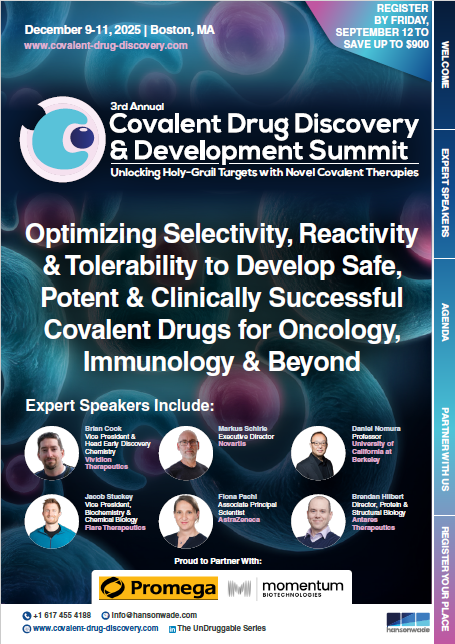7:30 am Check In & Light Breakfast
8:20 am Chair’s Opening Remarks
Targeting Previously Undruggable Proteins with Rational Target Selection to Expand the Potential of Covalent Therapies
8:30 am Increasing the Scope of Covalent Drugs to Transcription Factors & Hard to Drug Proteins with Strategic Target Selection
Synopsis
- Defining what makes a good target considering half life, non-covalent secondary interactions and ligandability
- Utilising modelling and ML to define pockets and calculate pocket size, solvent accessible surface area and PKa
- Strategies to reach previously undruggable targets with covalent modalities
9:00 am Structural Biology & Computational Challenges in Covalent Targeting of Cryptic Pockets
Synopsis
- Leveraging protein engineering to enable crystallography for transcription factors
- Overcoming structural biology challenges due to shallow, dynamic pockets
- Enabling covalent small molecule computational design
9:30 am Identification of Functional Covalent Hits with Novel Mechanisms of Action for Hard-to-Drug Targets
Synopsis
- Drugging elusive targets with high affinity, selectivity and tolerability
- Strategies for target selection and warhead tuning to facilitate selective, potent binding
10:00 am Unlocking the Regulome for Covalent Drug Discovery using a High- Throughput Proteomics Platform
Synopsis
- We developed regulome profiling, a platform to measure protein-chromatin binding activity of transcription factors and other chromatin-associated proteins from native cell contexts
- Protein-chromatin binding measurements are validated using tool compounds and proteins, such as MEN1
- Preliminary data from a covalent discovery program demonstrates androgen receptor and a splice variant can be reduced in prostate cancer by targeting the splicing factor NONO
10:30 am Morning Break & Speed Networking
Expanding the Druggable Proteome & Targeting Non-Cysteine Residues with Innovative Tools & Warhead Design to Expand Covalency Across More Indications
11:30 am Insights into Covalent Drug Discovery from FX-909
Synopsis
- FX-909 is a potent and selective inverse agonist of PPARG currently being explored in muscle-invasive luminal urothelial cancer
- FX-909’s selectivity and in vivo properties are derived from the “context-dependent reactivity” exhibited by its unique warhead
- Mechanistic investigations into covalent capture of PPARG were critical for the design and discovery of FX-909 and have also revealed insights into the physical basis of its “context-dependence”
12:00 pm Lysine-Targeted Covalent Probes with Residence-Time-Driven Selectivity
Synopsis
- Developing lysine-reactive kinase probes that reversibly engage over 200 cellular kinases, enabling broad profiling
- Engineering a salicylaldehyde-based probe that achieves residence-time-driven selectivity in cells and in vivo
- Demonstrated in vivo target engagement of PF-06873600 using the salicylaldehyde probe, highlighting translational potential
12:30 pm Round Table: Investigating the Feasibility of Targeting Non-Cysteine Residues & Developing Rational Strategies to Drug New Target
Synopsis
- Evaluating the suitably of non-cysteine residues for covalent targeting to assess feasibility of drugging novel proteins
- Exploring the technological advancements required to effectively identify and target alternative amino acids
- Optimizing warhead selectivity and potency to enable precise targeting whilst mitigating against off-target activity
1:00 pm Lunch & Networking
Optimizing Hit ID & Screening Capabilities with Chemoproteomics, Covalent Libraries & Computational Models to Identify Highly Promising Compounds
2:00 pm IMTAC™: A Chemoproteomic Platform for Covalent Ligand Discovery to Unlock Investigational Targets
Synopsis
- Leveraging covalent small-molecule libraries to rapidly identify diverse and hard-todrug targets
- Live-cell screening under physiological conditions captures native protein conformations and complex cellular dynamics and enhances translational relevance by mimicking in vivo target environments
- Key lessons learned and challenges overcome
2:30 pm Complementary Strategies for Covalent Hit Finding & Characterization
Synopsis
- Strategic application of labelling- vs. function-first approaches for covalent hit finding in vitro and in cells
- Chemoproteomics applications for hit characterization and determination of novel ligandable sites on targets of interest
- Library considerations for covalent hit finding at Novartis
3:00 pm RAPID – Photoaffinity-Based High-Throughput Ligand Discovery in Cells
Synopsis
- Pivoting away from mass spec in favor of building a high-throughput chemotherapeutics hit identification platform
- Discovery of first-in-class inhibitors of a genetically validated target for the treatment of PKU Discovery of the first inhibitors for transcription factor IRF3
- Evolving the platform to work with other covalent warheads
3:30 pm Afternoon Break & Poster Session
Applying Unique Proteomics Insights & Adopting Computational Modelling to Derisk Pipelines & Streamline Translation from Bench to Bedside
4:30 pm Developing a Proteomics Toolkit for the Characterization of Covalent Drug Molecules
Synopsis
- Pivoting away from mass spec in favor of building a high-throughput chemoproteomics hit identification platform
- Discovery of first-in-class inhibitors of a genetically validated target to treat PKU
- Discovery of the first inhibitors for transcription factor IRF3
- Evolving the platform to work with other covalent warheads
5:00 pm Computational & Machine Learning Approaches to Covalent Therapeutic Discovery
Synopsis
- How can computational simulation and machine learning accelerate the discovery of potent and selective covalent therapeutics?
- What are the limits of current approaches and which emerging techniques are showing promise?
- How can new simulation methods reveal covalent binding kinetics and guidemolecular design?

